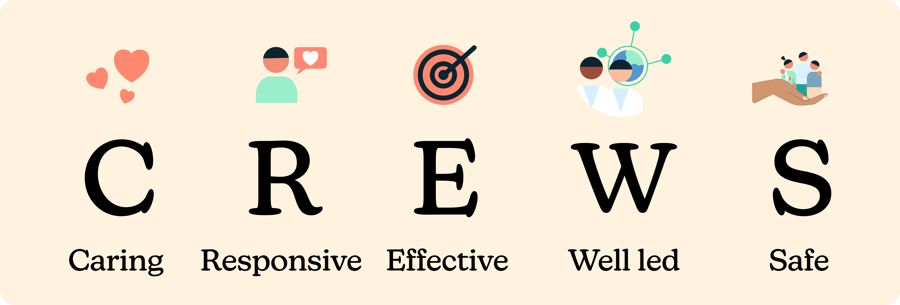CQC part 4: Ongoing CQC requirements and inspection ratings
Everything you need to keep on top of, including the ratings inspection.
Dr Anthony Langham
Physician and Healthtech specialist
When the CQC inspect your service, there will be certain criteria they will be marking you against. Here, we’ll walk you through what that criteria is, and how you can get yourself in the best position possible for your inspection.
What are the CQC inspection ratings?
There are four ratings that the CQC give to health and social care service providers:
Outstanding: The Service is performing exceptionally well.
Good: The service is performing well and meeting our expectations.
Requires Improvement: The service is not performing as well as it should, and we have told the service how it must improve.
Inadequate: The service is performing badly, and we've taken action against the person or organisation that runs it.
What are the ‘Five Key Lines of Enquiry’ the CQC asks during an inspection?
The CQC’s ‘Five Key Lines of Enquiry’ will be asked of all care services. These questions keep inspections consistent, and help inspectors decide what they need to focus on.
These questions are as follows:
Is this service safe?
Are patients protected from abuse and avoidable harm?
Is this service effective?
Does the service provide patients care and treatment thats based on the best available evidence and does it result in good outcomes?
Is this service caring?
Do the staff treat the patients with compassion, kindness, dignity and respect?
Is this service responsive to people’s needs?
Is the service organised so that it meets the needs of the patients?
Is this service well led?
Does the organisation's leadership, management, and governance structures ensure high-quality care based on patients' needs? Does the organisation encourage learning and innovation and promote an open and fair culture?
The CQC gives a rating for each of these Five Key Lines of Enquiry, as well as providing your service an ‘overall rating’. An easy way to remember these questions is with the acronym CREWS:

What is a CQC Quality Statement?
The best way to think of Quality Statements are as subdomains for each of the Five Key Lines of Enquiry. Using our CREWS acronym, these quality statements can be categorised as:

Caring
- Kindness, compassion and dignity
- Treating people as individuals
- Independence, choice and control
- Responding to people's immediate needs
- Workforce Wellbeing and Enablement
.png?width=150&height=150&name=Group%2062253%20(1).png)
Responsive
- Person-centred care
- Care provision, integration and continuity
- Providing information
- Listening to and involving people
- Equity in access
- Equity in experiences and outcomes
- Planning for the future

Effective
- Assessing patients needs
- Delivering evidence-based care and treatment
- How staff, teams and services work together
- Supporting people to live healthier lives
- Monitoring and improving outcomes
- Consent to care and treatment

Well led
- Shared direction and culture
- Capable, compassionate and inclusive leaders
- Freedom to speak up
- Workforce equality, diversity and inclusion
- Governance, management and sustainability
- Partnerships and communities
- Learning, improvement and innovation
- Environmental Sustainability
.png?width=150&height=150&name=Group%2062256%20(1).png)
Safe
- Learning culture
- Safe systems, pathways, and transitions
- Safeguarding
- Involving people to manage risks
- Safe environments
- Safe and effective staffing
- Infection prevention & control
What are the CQC’S evidence categories?
The other significant recent change over at the CQC is the types of evidence used to assess against the above quality statements.
There are six different types of evidence that they will be using to make a determination on these:
Feedback from service users
This is all types of evidence from people using your service, such as feedback forms conducted, direct feedback to the CQC, and patient participation groups.
Feedback from staff
This has been expanded in the CQC’s most recent update, and is now more critical than ever. Showing evidence from your workforce, such as the results of surveys, will ensure you can generate this evidence. It’s also very useful from a business planning point of view.
Feedback from partners
This is evidence from organisations that your service interacts with to provide care to patients, such as GP surgeries, other local providers, regulators, or multi-agency bodies.
Having a robust survey and feedback process in place for any ongoing partners you work with is crucial to generating this evidence. Consider a simple google form being sent out to your key partners once a quarter, and tracking the results over time.
Processes
The CQC inspection will also use ‘processes’ as an evidence type. They define processes as ‘any series of steps that are carried out for an organisation to deliver its objectives’.
This includes how organisations measure and respond to quality improvement projects such as audits, and how organisations manage, investigate and learn from incidents. (Think Quality Improvement Processes and incident reporting.)
Outcomes
Outcomes are focused on the impact of care processes on individuals. They cover how your organisation's care has affected people's physical, functional, or psychological status. For example, the CQC will review data on mortality rates, emergency admissions, vaccinations, and prescribing data. This can involve national benchmarking.
Observations
The CQC states on their website that “observing care and the care environment will remain an important way to assess quality”. This means that the inspectors will be observing the organisation during the inspection process and making a determination on the ranking of the service.
This is a more subjective type of evidence, which is dependent on your inspection team. Hence, ensuring the organisation has plenty of other evidence to provide during an inspection is vital.
Displaying ratings
By law, regulated healthcare providers have to display the ratings given to them by the CQC. This means you must display them in areas that you provide care, somewhere that people who use your service can easily see them. For traditional bricks and mortar business this means in the waiting area, or by reception. For digital health businesses this means displaying your rating clearly on your website.
.png?width=150&height=151&name=Dr%20Jonathan%20Andrews%20(2).png)
About Dr Anthony Langham
Dr Anthony Langham is an experienced Physician and Healthtech specialist. He is driven by enabling businesses to achieve success through technology enablements. He has succeeded in delivering complex and highly regulated technology solutions to businesses in the healthtech sector.